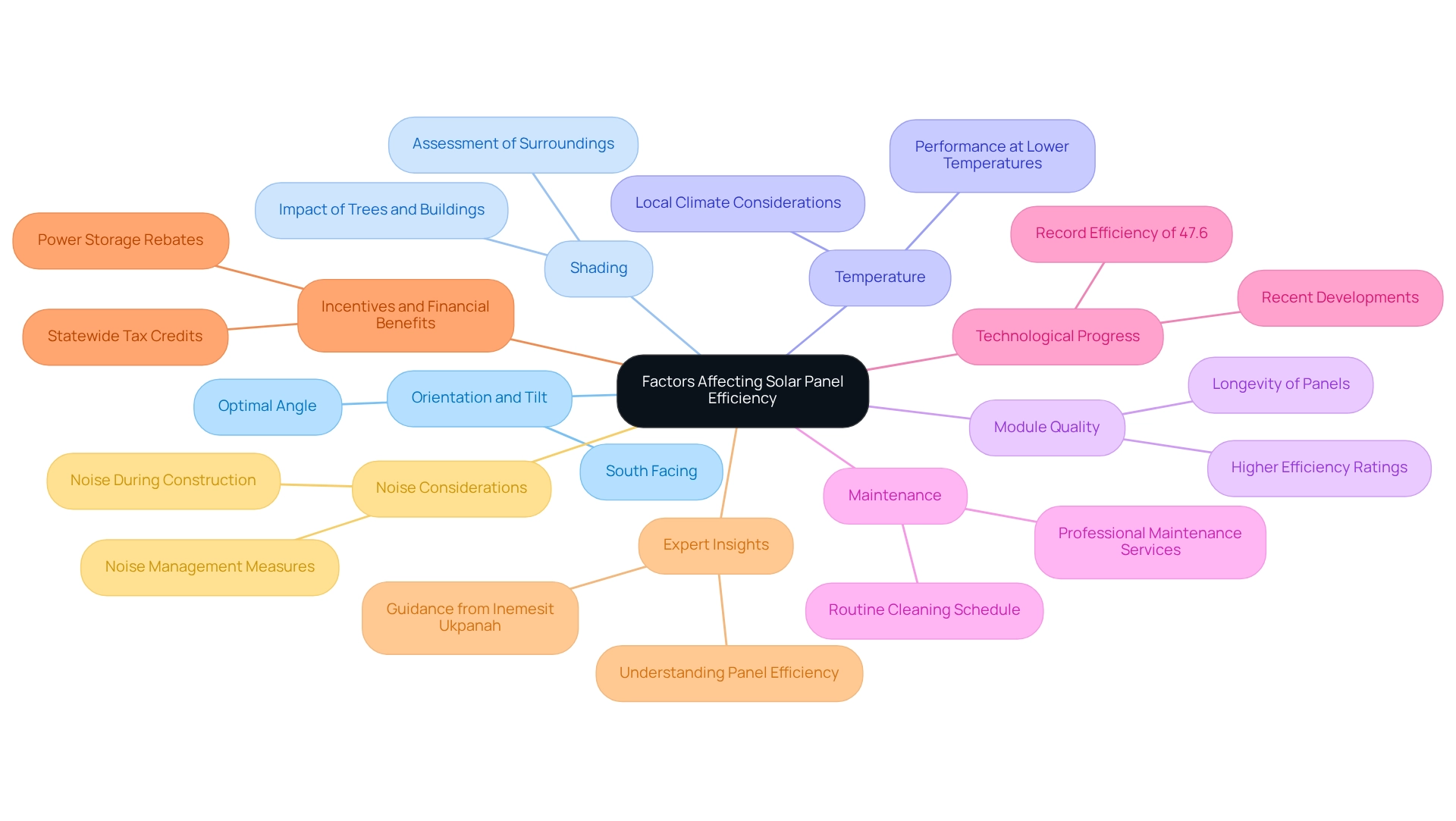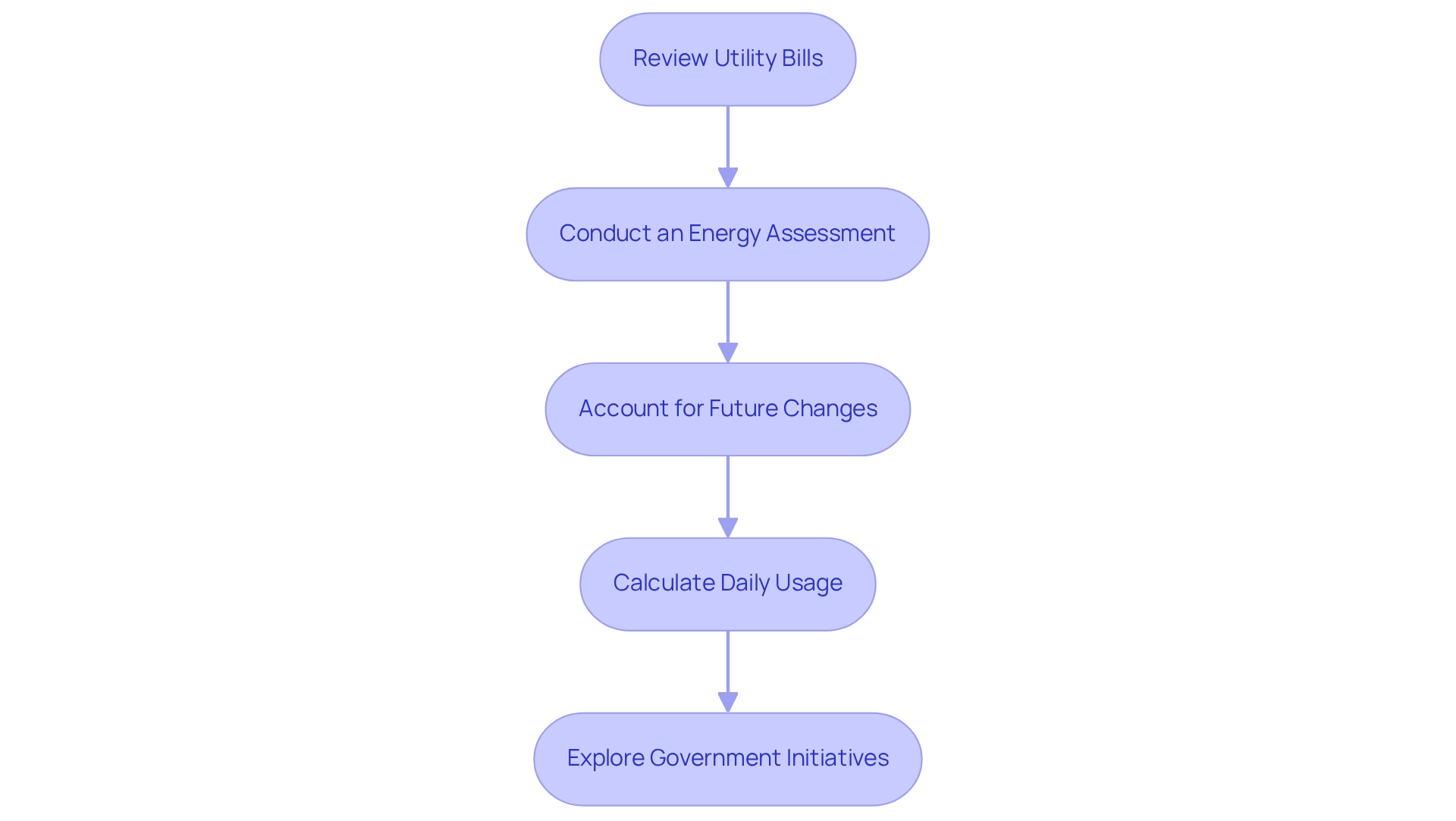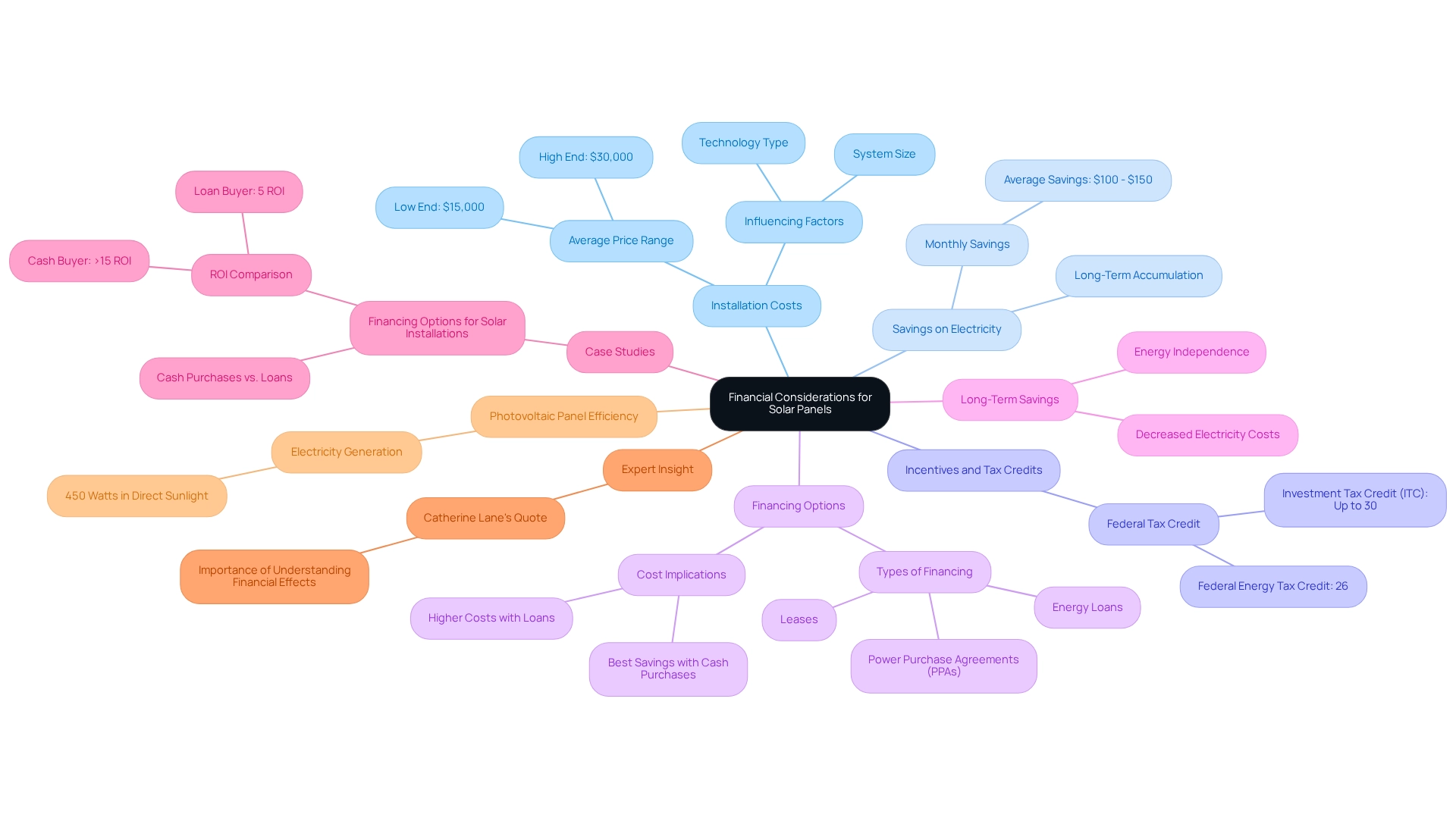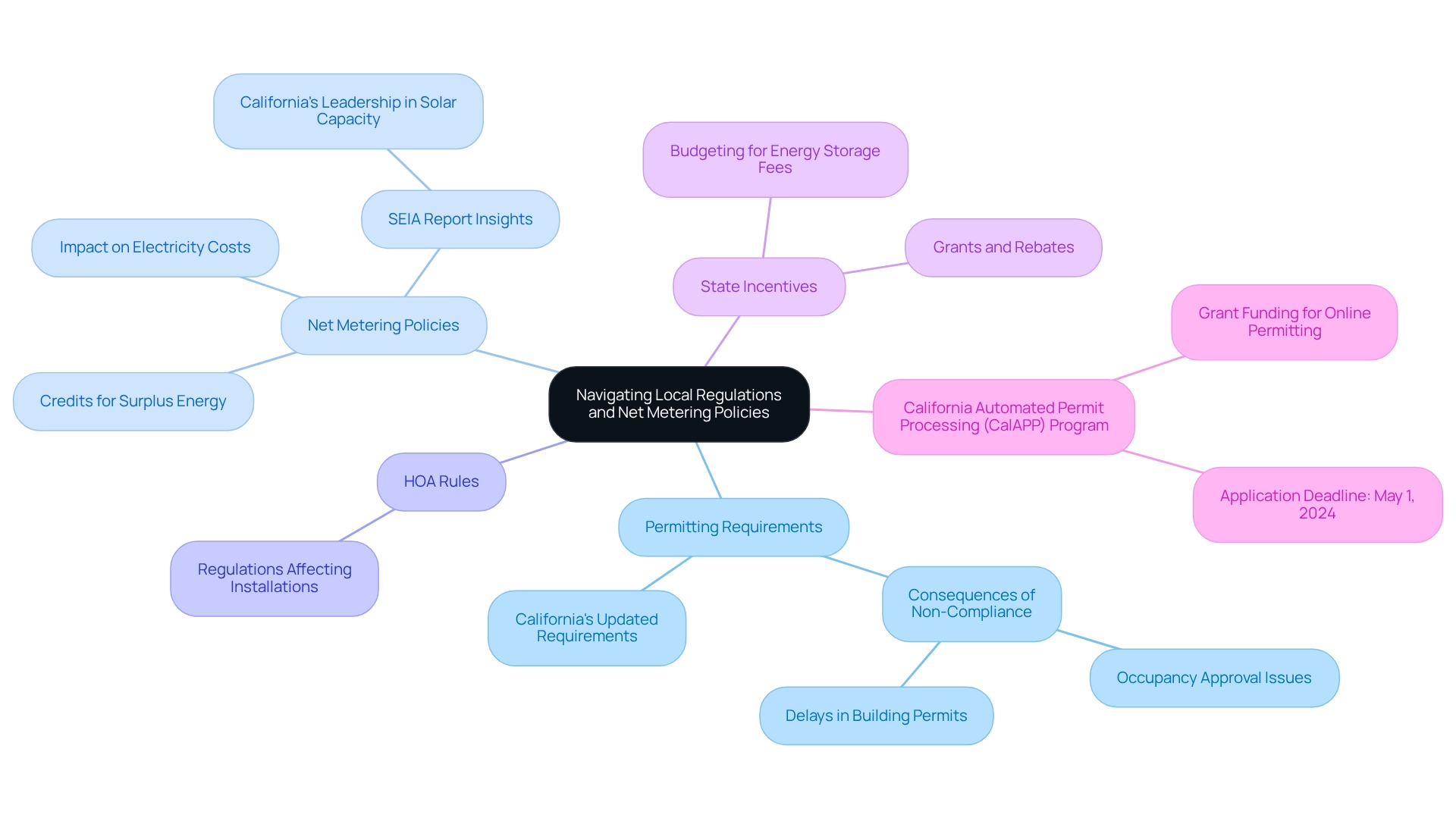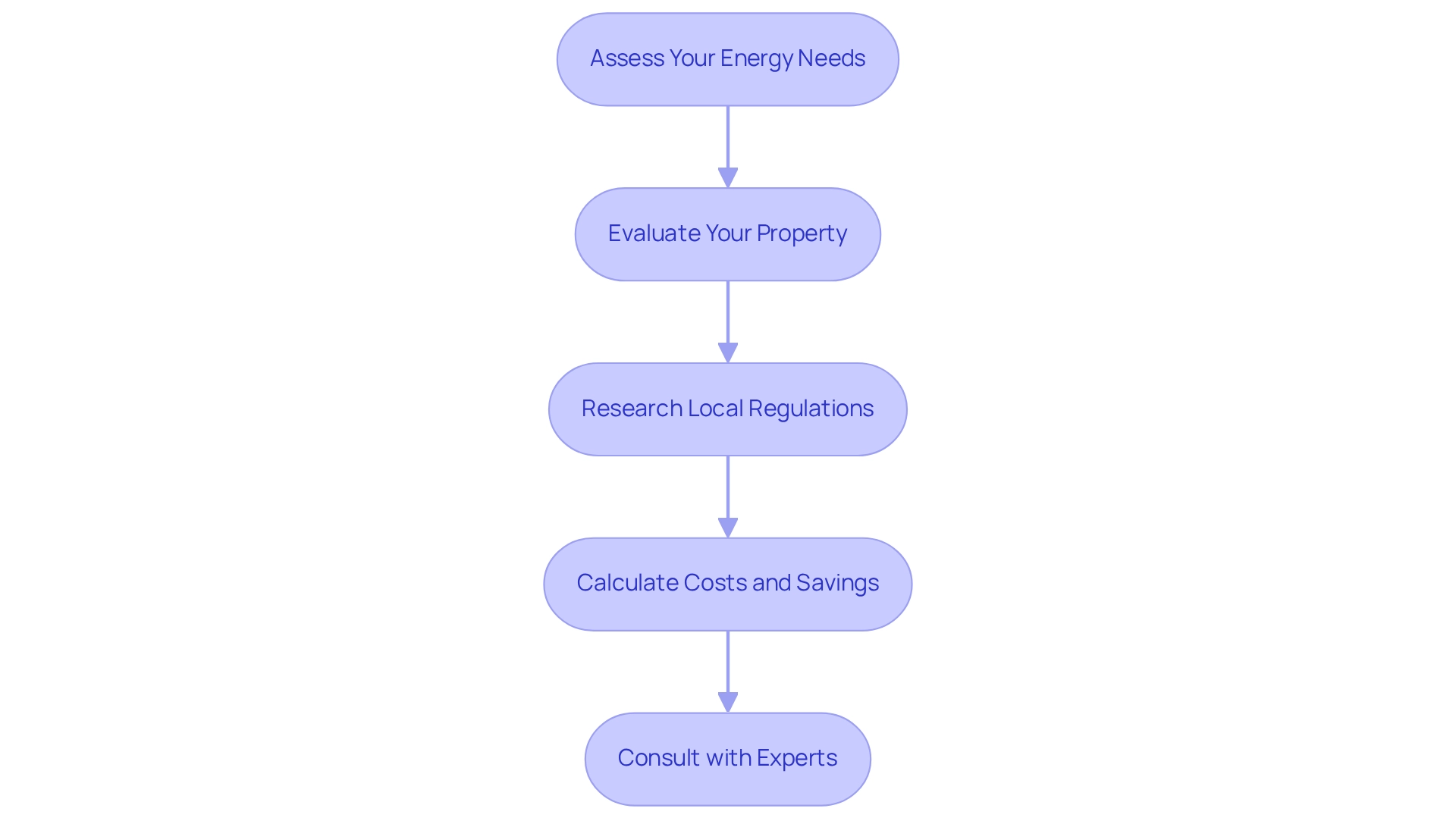Overview
Are you feeling overwhelmed by rising energy bills? You’re not alone. Many homeowners share this concern, and it’s completely understandable. This article explores how solar panels can potentially cover all your electricity needs, offering a pathway to energy independence. By assessing your energy consumption, understanding system size, and considering local regulations, you can take the first steps towards a more sustainable future.
Solar energy presents numerous benefits, not just in terms of cost savings but also in reducing your carbon footprint. It’s essential to consider factors like power usage and net metering policies, as these can significantly influence the effectiveness of solar panels. Imagine the peace of mind that comes with knowing you’re making a positive impact on the environment while also enjoying substantial savings.
We understand that navigating the world of renewable energy can be daunting. That’s why we’re here to guide you through this journey. Together, we can explore your options and find the best solutions tailored to your needs. If you’re ready to take the next step towards energy independence, don’t hesitate to reach out. Let’s work towards a brighter, more sustainable future together.
Introduction
In a world increasingly focused on sustainability, many homeowners are understandably concerned about rising energy costs and their environmental footprint. Solar panels have emerged as a beacon of hope, providing an opportunity to reduce expenses while also nurturing the planet.
These innovative devices convert sunlight into electricity, offering a myriad of benefits that extend beyond mere cost savings. The advantages of solar technology are compelling, including:
- Enhancing property value
- Promoting energy independence
We understand that navigating the complexities of installation, efficiency, and local regulations can be daunting, but you are not alone in this journey. This article delves into the essential aspects of solar energy systems, providing valuable insights to help you maximize your investment in renewable energy.
As California leads the charge in solar adoption, understanding these elements becomes crucial for anyone looking to harness the power of the sun. Together, we can work towards a brighter, more sustainable future.
Understanding Solar Panels: Basics and Benefits
Solar modules are innovative instruments that capture sunlight to produce electricity via the photovoltaic effect. Made up of many photovoltaic cells created from semiconductor substances, mainly silicon, these devices function by exciting electrons when sunlight hits them, thus generating direct current (DC) electricity. This DC electricity is then converted into alternating current (AC) for household use via an inverter, making it suitable for powering home appliances.
Benefits of Solar Panels:
- Cost Savings: We understand that managing electricity bills can be a significant concern for homeowners. Photovoltaic panels generate free power from sunlight, leading to substantial reductions in electricity expenses. In California, typical savings from photovoltaic installations can reach up to 70% on monthly utility costs, especially as service rates continue to rise.
- Environmental Impact: By harnessing sunlight, residents significantly reduce their dependence on fossil fuels, resulting in a decrease in carbon emissions. This shift not only benefits the environment but also aligns with California’s ambitious climate goals.
- Energy Independence: Solar arrays empower homeowners to generate their own electricity, fostering improved self-sufficiency and reducing vulnerability to grid failures. It’s common to wonder, do solar panels cover all my electricity? This is particularly crucial in California, where power reliability is a growing concern.
- Increased Property Value: Homes equipped with renewable energy systems often see a rise in property value. Studies indicate that properties with such installations can sell for up to 4% more than similar homes lacking these systems.
- Low Maintenance: Solar arrays are designed for durability and require minimal upkeep, primarily involving periodic cleaning and occasional inspections to ensure optimal performance.
Recent progress in photovoltaic technology has further enhanced efficiency, with many modules now reaching conversion rates surpassing 22%. Significantly, Emily Walker states, “Maxeon isn’t just our most efficient panel; it’s our top panel overall,” emphasizing the advancements in energy technology and efficiency. The Inflation Reduction Act is expected to enhance the deployment of photovoltaic systems by almost 66.9% in the coming five years, indicating a rising trend towards sustainable power solutions.
As California navigates the complexities of its net metering policy, which has influenced installation rates, the latter half of the 2020s is expected to witness a resurgence in residential renewable energy growth, driven by emerging state markets.
In summary, the shift to renewable energy not only provides financial advantages but also aids in creating a sustainable future, making it an increasingly appealing choice for residents in California. Together, we can embrace this transition. Powercore Electric, with its personalized service and in-house expertise, stands ready to support homeowners in this journey, ensuring high-quality installations and maintenance. Contact Powercore Electric for your free estimate today!
Can Solar Panels Eliminate Your Electricity Bill?
While solar panels can lead to substantial reductions in electricity bills, it’s common to wonder: do solar panels cover all my electricity entirely? The degree of savings is influenced by several key factors that we should consider together:
-
Power Usage: Increased power consumption requires a bigger panel system to balance expenses efficiently. In 2025, the typical electricity usage for California homes is expected to be approximately 600 kWh per month, highlighting the significance of customizing renewable solutions to personal requirements.
-
System Size: A well-structured photovoltaic system can meet a substantial part of your power needs. However, achieving a zero electricity bill is uncommon, raising the question of whether solar panels can cover all my electricity, as most systems are designed to offset a percentage of usage rather than eliminate it completely.
-
Net Metering: Many states, including California, have net metering policies that enable residents to sell surplus energy produced back to the grid. This can further decrease electricity expenses, making photovoltaic energy an even more appealing choice. Recent updates in 2025 have reinforced the benefits of net metering, offering property owners additional financial incentives.
-
Utility Fees: Even with energy collectors installed, residents may still encounter connection fees or minimum charges from their utility providers. These costs can vary significantly, impacting overall savings.
In reality, an increasing number of property owners are discovering that photovoltaic systems can help answer the question: do solar panels cover all my electricity expenses? Recent statistics suggest that around 30% of property owners in California are attaining near-zero electricity expenses, prompting the inquiry of whether solar panels cover all my electricity needs through efficient photovoltaic systems. This trend emphasizes the possibility for renewable power to transform domestic consumption.
Additionally, well-known renewable incentives, such as statewide tax credits and storage rebates, can further improve the financial advantages for residents contemplating photovoltaic systems. As Ben Zientara, a renewable energy policy analyst, noted, “Time will tell whether these early actions will cause major impediments for energy companies or whether President Trump’s promises to ‘unleash American energy’ will include making it easier to install panels on homes, businesses, and land all across the country.”
As the energy industry evolves, understanding these factors will be crucial for homeowners considering energy solutions. The start of 2025 is characterized by uncertainty due to possible funding pauses from the Inflation Reduction Act and tariffs impacting imports of solar technology, raising concerns among energy companies. This situation highlights the necessity for state-level incentives to enhance renewable energy demand and reduce the effect of federal policy changes on the industry.
With the correct method, photovoltaic panels can greatly lower power expenses and aid in creating a more sustainable future.
Furthermore, property owners should think about incorporating Tesla home chargers into their renewable solutions, as these can improve efficiency and offer convenient charging options for electric vehicles. Government initiatives and incentives can also play a crucial role in making renewable resources more accessible and affordable. Additionally, routine maintenance services for photovoltaic systems can guarantee peak efficiency and durability, enhancing the advantages of renewable power for environmentally conscious residents.
Powercore Electric is dedicated to assisting residents in Southern California explore these choices and make knowledgeable decisions about their renewable solutions. Together, we can navigate this journey towards energy independence and sustainability.
Factors Affecting Solar Panel Efficiency and Output
Many homeowners are understandably concerned about rising energy bills and seeking ways to optimize their savings. One vital solution lies in photovoltaic devices, which can significantly enhance energy generation and provide financial relief.
- Orientation and Tilt: To achieve optimal performance, it’s essential that these devices face south and are inclined at an angle that captures maximum sunlight throughout the year. This simple adjustment can increase output by up to 20% compared to poorly oriented systems, making a substantial difference in energy savings.
- Shading: It’s common to overlook the impact of shading from trees, buildings, or other obstructions. Even partial shading can drastically reduce energy output, so assessing the surrounding environment before installation is crucial. Homeowners might consider trimming trees or relocating equipment to avoid shaded areas, ensuring their systems operate at peak efficiency.
- Temperature: Interestingly, photovoltaic systems function more effectively at lower temperatures. While they are built to withstand heat, excessive temperatures can hinder performance. This highlights the importance of considering local climate conditions when evaluating photovoltaic options, as varying climates can influence the overall efficiency of these systems.
- Module Quality: The quality of solar modules is another key factor affecting efficiency and longevity. Opting for higher-quality panels typically results in better efficiency ratings and longer lifespans, making them a worthwhile investment. We encourage homeowners to research and select panels from reputable manufacturers known for their performance and durability.
- Maintenance: Regular maintenance is essential to ensure optimal performance. Accumulations of dirt, debris, or snow can obstruct sunlight absorption, leading to decreased power output. Establishing a routine cleaning schedule and exploring innovative cleaning solutions or professional maintenance services can help keep systems running efficiently, ensuring homeowners continue to benefit from their investments.
- Technological Progress: Staying informed about recent developments in photovoltaic technology can empower homeowners. For instance, the record efficiency of 47.6% achieved by Fraunhofer ISE’s III-V four-junction CPV cells demonstrates the potential for increased power generation and cost savings. Keeping updated on these innovations can assist homeowners in making informed decisions regarding their energy investments.
- Incentives and Financial Benefits: Homeowners should also explore available incentives, such as statewide tax credits and power storage rebates, which can significantly reduce the upfront costs of photovoltaic installations. These financial advantages make transitioning to renewable sources more attainable and attractive, further promoting eco-friendly choices.
- Expert Insights: Engaging with expert insights, like those from experienced content creator Inemesit Ukpanah, can provide valuable guidance in selecting the right energy solutions. Understanding the subtleties of panel efficiency is essential for residents aiming to make knowledgeable choices regarding their power systems.
- Noise Considerations: Additionally, it’s important to address potential concerns regarding noise pollution from PV systems. A case study on noise pollution highlights that noise can arise during the construction, operation, and upkeep of PV systems, necessitating stricter noise management measures for installations close to residential areas.
By recognizing these factors, homeowners can make informed choices about their renewable power systems, ultimately leading to greater autonomy and cost savings. Together, we can navigate the path towards a sustainable energy future.
Assessing Your Energy Consumption: A Key to Solar Success
To determine if solar panels can adequately cover your electricity needs, it’s essential to start with a thorough assessment of your energy consumption. We understand that managing energy bills can be a concern for many homeowners, and addressing this is the first step towards a more sustainable future.
- Review Utility Bills: Begin by examining your electricity bills from the past year to calculate your average monthly usage in kilowatt-hours (kWh). This will help establish a baseline for understanding your power requirements.
- Conduct an Energy Assessment: A home consumption audit is crucial for identifying opportunities to reduce usage. This process can uncover enhancements, such as upgrading to energy-saving appliances or improving insulation, which can significantly lower your total consumption. It’s important to note that heating and cooling account for 52% of all power consumption in U.S. residences, making efficiency a key focus during audits.
- Account for Future Changes: Consider any upcoming modifications that may impact your power usage, such as the addition of electric vehicles or other high-demand devices. Preparing for these changes ensures your energy system can meet your future requirements.
- Calculate Daily Usage: To find your average daily consumption, simply divide your annual usage by 365. This figure is crucial for determining whether solar panels can meet all your electricity needs.
In California, the average household consumes approximately 550 kWh per month, which translates to about 18 kWh per day. Understanding these figures is vital for effective solar planning. Moreover, power assessments have been shown to result in substantial savings; many residents report decreases of 20% or greater in their utility bills after implementing suggested modifications.
As Kelly Bedrich, president and chief technology officer of Powercore Electric, emphasizes, “Our commitment to personalized service ensures that homeowners receive tailored advice that aligns with their power objectives.”
Additionally, Long Beach tenants should explore existing government initiatives and incentives that can promote the adoption of renewable power, making it more attainable and economical. The financial and ecological advantages of solar heating systems, including both active and passive solutions, should also be considered, as they can enhance power efficiency and sustainability in your home.
By examining your utility statements and performing a thorough assessment of power usage, you can make informed choices regarding your panel installation to determine if solar panels cover all your electricity needs while ensuring it aligns with your power requirements and sustainability objectives. Furthermore, residents in deregulated regions may have the opportunity to reduce their utility expenses by opting for a plan with a lower rate, which is a significant factor in evaluating overall consumption. Together, we can work towards a more sustainable and cost-effective energy solution for your home.
The Role of Solar Battery Storage in Meeting Energy Needs
Are you feeling overwhelmed by rising energy bills? Solar battery storage systems can be a game changer, offering a range of benefits that significantly enhance your experience as a homeowner:
- Power Availability: These systems capture surplus power generated during sunny days, allowing you to utilize this stored power at night or during overcast conditions. This capability guarantees a steady power supply, regardless of weather fluctuations.
- Backup Power: In the event of a power outage, solar battery storage provides a reliable backup power source. This feature is crucial for maintaining the operation of essential appliances, ensuring that your home remains functional during disruptions.
- Cost Savings: You can attain significant savings by using stored power during peak hours when electricity rates are highest. This strategic application of resources not only lowers your monthly expenses but also enhances overall efficiency.
- Enhanced Autonomy: By incorporating battery systems, you can significantly lessen your dependence on the grid, promoting greater power independence. This self-sufficiency is especially beneficial in California, where utility costs are rising and the demand for dependable power sources is increasing.
Recent trends show an increasing uptake of photovoltaic battery storage in California, with numerous property owners acknowledging the long-term economic and ecological advantages. For instance, energy storage experts highlight that these systems not only enhance energy independence but also provide a buffer against fluctuating energy prices. As of 2025, the average savings from using battery storage during peak hours can be significant, making it a smart investment for environmentally aware residents.
Moreover, it’s common to feel uncertain about the financial landscape for renewable energy investments. Recent reductions in net metering benefits mean that property owners are now receiving less compensation for excess power generated. This transition underscores the significance of battery storage systems, which can assist in alleviating the effects of these changes by enabling you to store and utilize your renewable power more efficiently.
The case study titled ‘Financial Impact of Net Metering Cuts’ illustrates how these reductions have changed the economics of rooftop power generation, emphasizing the need for effective storage solutions.
Additionally, the broader trend of substantial corporate investment in renewable resources, as demonstrated by Amazon, Google, and Meta’s combined contracted pipeline of over 25 GW, underscores the increasing significance of photovoltaic alternatives in today’s power landscape. This context emphasizes the importance of battery storage systems for property owners like you.
In summary, battery storage systems are not merely an accessory to panels; they are a crucial element that improves availability, offers backup power, delivers cost savings, and encourages independence. Together, we can make informed choices that optimize your renewable power systems. As Michael Nyberg from the California Energy Commission states, “Come be part of creating a clean, modern and thriving California,” which underscores our collective effort towards sustainable power solutions. Powercore Electric provides a variety of high-quality battery options designed to meet the requirements of eco-conscious homeowners, ensuring you can optimize your renewable energy investments.
Financial Considerations: Costs, Savings, and Incentives
When considering solar panels, it’s essential to evaluate the financial implications with care and understanding:
- Installation Costs: We understand that as of 2025, the average price of a residential renewable energy system in California varies from $15,000 to $30,000, influenced by factors such as system size and technology. This investment can significantly impact your long-term energy savings, especially when compared to traditional electricity costs, which can average around $200 per month for homeowners.
- Savings on Electricity Expenses: Homeowners can look forward to saving between $100 to $150 each month on electricity expenses after installing photovoltaic systems. Over time, these savings can accumulate to thousands of dollars, making this energy option a financially sound choice compared to relying solely on conventional electricity.
- Incentives and Tax Credits: It’s comforting to know that federal and state incentives, including the Investment Tax Credit (ITC), can reduce installation costs by up to 30%. After utilizing the federal energy tax credit of 26%, the total cost of panel installation becomes significantly more feasible, enhancing the return on investment for homeowners.
- Financing Options: We recognize that homeowners have access to various financing alternatives, such as energy loans, leases, and power purchase agreements (PPAs). While these options offer flexibility, it’s important to note that photovoltaic loans may lead to higher overall expenses due to interest and dealer charges. Cash purchases generally result in the best long-term savings, highlighting the necessity for thorough financial assessment before investing in renewable energy.
- Long-Term Savings: The financial advantages of photovoltaic panels extend beyond initial savings. Over time, property owners can anticipate significant decreases in their electricity costs, aiding in energy independence and sustainability. This is particularly relevant when considering if solar panels can cover all your electricity needs and when combined with electric vehicle (EV) charging solutions.
- Case Studies: For instance, a recent examination of funding choices for photovoltaic installations indicated that although financing can alleviate the initial burden, cash purchases typically provide the greatest long-term savings. In one case, a property owner who funded their energy system observed a return on investment of just 5% over 20 years, whereas a cash buyer achieved a return of more than 15% during the same timeframe. This emphasizes the significance of evaluating financial strategies when investing in renewable energy technology.
- Expert Insight: As Catherine Lane, Written Content Manager at SolarReviews, notes, “Comprehending the financial effects of renewable energy is crucial for residents seeking to make informed choices about their power future.”
- Photovoltaic Panel Efficiency: Common photovoltaic panels can generate approximately 450 watts of electricity in direct sunlight, greatly aiding in total savings on electricity expenses and improving the effectiveness of household power systems.
By understanding these financial factors, property owners can make educated choices regarding a shift to renewable energy, ultimately leading to improved energy efficiency and cost reductions. Together, we can ensure that Powercore Electric’s internal group of specialists guarantees top-notch installations and upkeep, establishing them as a reliable option for your energy and electrical needs.
Navigating Local Regulations and Net Metering Policies
Before you embark on the journey of solar panel installation, it’s important to understand the local regulations and net metering policies that will guide your transition to solar energy. We know this can feel overwhelming, but you’re not alone in this process.
- Permitting Requirements: It’s essential to consult with local authorities to identify the necessary permits for solar installations. As of 2025, California has updated its permitting requirements, which property owners must comply with to avoid delays in securing building permits and occupancy approvals. Smaller areas are expected to meet these requirements by 2023. Non-compliance can lead to significant setbacks, as illustrated by the case study titled “Consequences of Non-Compliance with the California Solar Mandate,” which highlights potential delays in securing building permits and final occupancy approval for new homes. Together, we can navigate these requirements, and Powercore Electric is here to support you in ensuring compliance and timely installation.
- Net Metering Policies: Understanding how net metering operates in your area is crucial. This policy allows property owners to earn credits for any surplus energy produced by their photovoltaic panels that is returned to the grid. In California, net metering policies have evolved, providing substantial benefits to homeowners by offsetting electricity costs. As of 2025, a significant percentage of renewable energy users are taking advantage of these credits, raising an important question: do solar panels cover all my electricity bills? This can lead to considerable savings. According to a report by the Solar Energy Industries Association (SEIA), California installed more photovoltaic capacity in 2021 than any other state in the US, showcasing the state’s leadership in renewable energy solutions. Powercore Electric offers consultation services to help you understand and maximize these benefits.
- Homeowners Association (HOA) Rules: If your property is governed by an HOA, it’s crucial to examine any regulations that may affect the installation of photovoltaic panels. Some associations may have specific requirements or restrictions that could impact your plans.
- State Incentives: Investigating state-specific incentives can further reduce installation costs and enhance long-term savings. California offers various initiatives aimed at encouraging the adoption of renewable sources, including grants and rebates that can significantly lower initial costs. Additionally, as you budget for your solar project, consider potential fees related to energy storage battery systems, which may require additional permits. Powercore Electric can provide you with information on available incentives and assist you with the application process.
- California Automated Permit Processing (CalAPP) Program: This program provides grant funding to assist jurisdictions in implementing the required online permitting platform, with applications accepted until May 1, 2024. This information is current and relevant for property owners contemplating renewable energy installations. Powercore Electric is well-versed in this program and can guide you through the permitting process.
By understanding these essential factors and utilizing the expertise of Powercore Electric, you can make informed choices that enhance the benefits of renewable energy while ensuring compliance with local regulations. Together, let’s work towards a sustainable future.
Step-by-Step Evaluation: Is Solar Right for You?
To determine if solar panels are the right fit for your home, especially for eco-conscious renters in Long Beach, it’s essential to follow these steps with care and consideration:
-
Assess Your Energy Needs: We understand that reviewing your electricity bills can feel overwhelming, but it’s a crucial first step. Take a moment to identify your average monthly consumption. A thorough resource assessment can assist you in understanding your usage patterns and pinpointing areas for potential savings. Think about how renewable power solutions, like Tesla home chargers, can align with your power requirements.
-
Evaluate Your Property: It’s common to feel unsure about your roof’s suitability for solar panels. Examine its condition, orientation, and shading. A roof that faces south with minimal shading is ideal for installing photovoltaic systems, maximizing sunlight exposure and power generation. Additionally, consider shingles that harness sunlight, which can provide both visual appeal and practical advantages, enhancing your home’s efficiency.
-
Research Local Regulations: Familiarizing yourself with the permitting process and net metering policies in your area is vital. Understanding these regulations ensures a seamless installation and helps you fully benefit from available incentives, including government panel programs that can significantly reduce your initial expenses. For Long Beach renters, programs such as the California Solar Initiative and local rebates can provide substantial financial assistance.
-
Calculate Costs and Savings: Estimating installation expenses based on your energy usage and the dimensions of the energy system required can feel daunting. However, consider the potential savings on your electricity bills, which can be significant, especially during peak pricing hours. Recent data indicates that 1.1 GW of residential photovoltaic systems was installed in Q4 2024, reflecting a growing trend in energy adoption that can lead to considerable long-term savings for homeowners.
-
Consult with Experts: Engaging with installation professionals can provide you with personalized assessments and recommendations tailored to your specific situation. Their expertise can guide you through the assessment process, ensuring you make informed choices about the best energy inverters and battery alternatives for your home.
By following these steps, you can effectively evaluate whether solar panels will cover your electricity needs and help reduce your energy expenses. As Dr. Mark Z. Jacobson, Director of the Atmosphere/Energy Program at Stanford University, points out, “Installing photovoltaic (PV) systems on your roof decreases the electricity you need to import from the grid, especially during periods of high electricity prices, in the afternoons.” Furthermore, advancements in photovoltaic technology continue to improve, resulting in lower PV prices and increased efficiency in electric appliances for all-electric homes.
This evolving landscape presents increasing opportunities for homeowners to install solar panels, making it essential to assess your property for solar suitability. Together, we can explore these options and work towards a more sustainable future.
Conclusion
We understand that managing energy bills can be a source of stress for many homeowners. Embracing solar energy is not just a financial decision; it’s a transformative step towards achieving both savings and environmental sustainability. The benefits of solar panels are extensive, offering significant reductions in electricity bills, increased property value, and a sense of energy independence. Homeowners in California, in particular, can truly benefit from the state’s supportive policies and incentives that make the transition to renewable energy sources more accessible.
It’s common to feel overwhelmed by the nuances of solar panel installation, including energy consumption assessments, local regulations, and the importance of solar battery storage. However, understanding these elements is crucial for maximizing the potential of this investment. By carefully evaluating energy needs and exploring financing options, you can make informed decisions that align with your sustainability goals while enjoying long-term economic benefits.
As the solar industry continues to evolve, advancements in technology and shifting policies highlight the importance of staying informed. With expert guidance from companies like Powercore Electric, you can navigate this landscape effectively, ensuring that your solar energy systems are not only compliant but also optimized for performance. Together, we can embark on this journey towards a greener future, beginning with the informed choices you make today, paving the way for a sustainable tomorrow.




